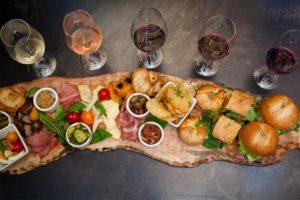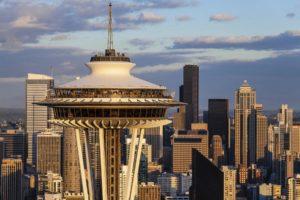Bicycling
Biking is probably Seattle's most popular sport. Thousands of Seattleites bike to work, and even more ride recreationally, especially on weekends. In the past, Seattle hasn't been a particularly bike-friendly city. But in 2007, city government adopted a sweeping Bicycle Master Plan, calling for 118 new miles of bike lanes, 19 miles of bike paths, and countless route signs and lane markings throughout the city by 2017. The plan can't erase the hills, though—only masochists should attempt Queen Anne Hill and Phinney Ridge. Fortunately, all city buses have easy-to-use bike racks (on the front of the buses, below the windshield) and drivers are used to waiting for cyclists to load and unload their bikes. If you're not comfortable biking in urban traffic—and there is a lot of urban traffic to contend with here—you can do a combination bus-and-bike tour of the city or stick to the car-free Burke-Gilman Trail.
Seattle drivers are fairly used to sharing the road with cyclists. With the exception of the occasional road-rager or clueless cell-phone talker, drivers usually leave a generous amount of room when passing; however, there are biking fatalities every year, so be alert and cautious, especially when approaching blind intersections, of which Seattle has many. You must wear a helmet at all times (it's the law) and be sure to lock up your bike—bikes do get stolen, even in quiet residential neighborhoods.
The Seattle Parks Department sponsors Bicycle Sundays on various weekends from May through September. On these Sundays, a 4-mile stretch of Lake Washington Boulevard—from Mt. Baker Beach to Seward Park—is closed to motor vehicles. Many riders continue around the 2-mile loop at Seward Park and back to Mt. Baker Beach to complete a 10-mile, car-free ride. Check with the Seattle Parks and Recreation Department (206/684–4075 www.seattle.gov/parks/bicyclesunday) for a complete schedule.
The trail that circles Green Lake is popular with cyclists, though runners and walkers can impede fast travel. The city-maintained Burke-Gilman Trail, a slightly less congested path, follows an abandoned railroad line 14 miles, roughly following Seattle's waterfront from Ballard to Kenmore, at the north end of Lake Washington. (From there, serious cyclists can continue on the Sammamish River Trail to Marymoor Park in Redmond; in all, the trail spans 42 miles between Seattle and Issaquah.) Discovery Park is a very tranquil place to tool around in. Myrtle Edwards Park, north of Pier 70, has a two-lane waterfront path for bicycling and running. The islands of the Puget Sound are also easily explored by bike (there are rental places by the ferry terminals), though keep in mind that Bainbridge, Whidbey, and the San Juans all have some tough hills.
King County has more than 100 miles of paved and nearly 70 miles of unpaved routes, including the Sammamish River, Interurban, Green River, Cedar River, Snoqualmie Valley, and Soos Creek trails. For more information contact the King County Parks and Recreation office (206/296–4232).
Washington Bikes. The state's largest cycling advocacy group is a great source for information. 314 1st Ave. S, Pioneer Square, Seattle, Washington, 98104. 206/224–9252; www.wabikes.org.
Cascade Bicycle Club. The Cascade Bicycle Club organizes more than 1,000 rides annually for recreational and hard-core bikers. The most famous of its events is the Seattle-to-Portland Bicycle Classic—or, as it's known around the state, the "STP." Cascade offers daily rides in Seattle and the Eastside that range from "superstrenuous" to leisurely, such as the relaxed rides to the Red Hook Brewery in Woodinville. 206/522–3222; www.cascade.org.
Seattle Bicycle Program. The Seattle Bicycle Program was responsible for the creation of the city's multiuse trails (aka bike routes) as well as pedestrian paths and roads with wide shoulders—things, in other words, that benefit bicyclists. The agency's website has downloadable route maps; you can also call the number listed to request a free full-color printed version of the Seattle Bicycling Guide Map. 206/684–7583; www.seattle.gov/transportation/bikeprogram.htm.
Pronto Cycle Share. With dozens of stations interspersed throughout the city, Pronto Cycle Share is the easiest way to hop on a bike. For $8, riders can rent a seven-speed road cruiser at one of Pronto's automated stations and drop the bike off at any of the city's other Pronto Cycle locations. The first 30 minutes is included in rental, with $2 for the next 30, and $5 for each 30 after that. Those looking for multiple rides can score a three-day pass for $16. Helmets are also included and can be picked up at each station. 844/677--6686; www.prontocycleshare.com.
Rentals
Montlake Bicycle Shop. This shop a mile south of the University of Washington and within easy riding distance of the Burke-Gilman Trail rents mountain bikes, road bikes, basic cruisers, and tandems. Prices range from $50 to $110 for the day, with discounts for longer rentals (credit card hold required). If you find yourself on the Eastside, you can rent a bike from its Kirkland branch. 2223 24th Ave. E, Montlake, Seattle, Washington, 98112. 206/329–7333; www.montlakebike.com.
Montlake Bicycle Shop. Kirkland Bicycle Shop, 208 Kirkland Ave., Kirkland, Washington, 98033. 425/828–3800; www.montlakebike.com.









